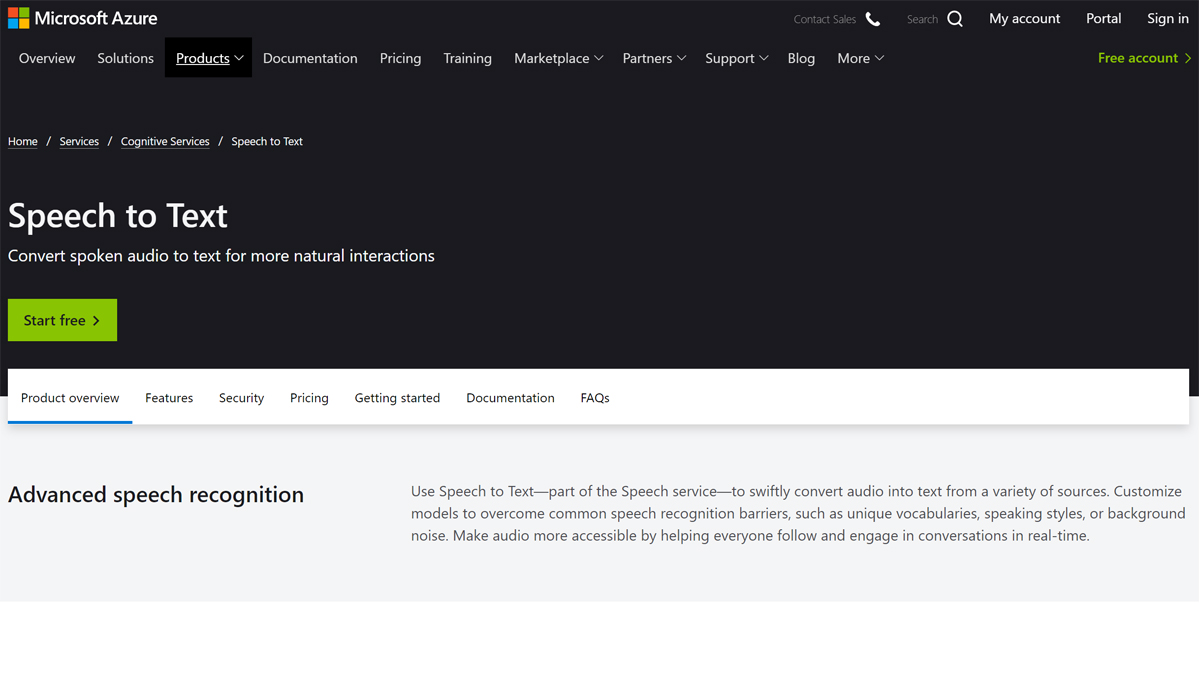

- #AZURE SPEECH TO TEXT SERVICE REGION INSTALL#
- #AZURE SPEECH TO TEXT SERVICE REGION CODE#
- #AZURE SPEECH TO TEXT SERVICE REGION DOWNLOAD#
- #AZURE SPEECH TO TEXT SERVICE REGION FREE#
- #AZURE SPEECH TO TEXT SERVICE REGION WINDOWS#
If (result.RecognitionStatus != RecognitionStatus.Recognized)Ĭonsole.WriteLine($"Recognition status: ") Ĭonsole.WriteLine("Please press a key to continue.") Var result = await recognizer.RecognizeAsync() Text to speech (TTS) has attracted a lot of attention recently due to advancements in deep learning. below I said “Testing 123” and it converted it to text and displayed it on the screen: After saying something, it will appear in text, i.e. Once we get a response from the Speech API, we can use this to look perform any number of actions.
#AZURE SPEECH TO TEXT SERVICE REGION WINDOWS#
#AZURE SPEECH TO TEXT SERVICE REGION CODE#
Then you need to provide your subscription key and SAS URL as per below code snippet. From your favorite python IDF, open the python code in this URL. You can use the Python library that you generated with the Speech service samples on GitHubĪzure provides sample python code that uses the python SDK in this repository. Check that the installation has worked: python -c "import swagger_client"
#AZURE SPEECH TO TEXT SERVICE REGION INSTALL#
#AZURE SPEECH TO TEXT SERVICE REGION DOWNLOAD#
Swagger allows users to download client SDKs in many languages. OpenAPI Specification/Swagger is the most widely used REST API definition standard. Azure exposes their speech service REST API definitions via swagger. The next step is to download the Python SDK. Simple response contains the below format. Setting up relevant transfer encoding settings will help to speed up the translation process. Relevant curl commands can be found here. But SDK supports a wide variety of audio file types including mp3. REST API support WAV and OGG audio formats. You may need to changes the region(westus) based on the location that you created the service. I’m adding the python code to get the access token which is available in the documentation. In order to access the speech services, you will need to first obtain an access token by providing the access key that you obtain in the previous step. My code repository relevant to this article is located in this link. SDKs are available for most of the core languages including in Python, C#, C++, Java, JavaScript, Objective-C/SWIFTĪzure speech services Github repository contains helpful resources. SDKs abstract out underline complexities and provide programmatic user-friendly API to quickly integrate with your applications. Speech SDK: Azure provides language-specific SDKs to invoke speech cognitive services.

More details with examples can be found in the Azure documentation.
#AZURE SPEECH TO TEXT SERVICE REGION FREE#
Students can get up to free 100$ without providing a credit card.A new user will get up to free 200$ credits.In the first phase of the article, I’m going to provide details on performing audio transcription from the Azure python speech SDK. Here I’m going to provide an overview of accessing Azure speech cognitive services through a python client and an overview of Speech-To-Text services.Īzure provides diversified speech-to-text capabilities through various services. I was able to transcribe mono-channel telephone conversation audio clips which even contain some background noises with great accuracy without performing tuning from the Azure cognitive services. Recently I have evaluated Speech-to-Text cognitive services from major cloud providers and decided to go ahead with Azure due to the accuracy of my sample clips. With the recent NLP advancements, accurate transcription of audio plays an important role to extract valuable information.

Speech-To-Text applications are becoming vital in converting audio to text content.


 0 kommentar(er)
0 kommentar(er)
